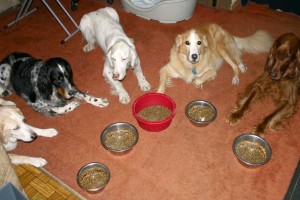Mealtime Madness! Part 2
Many multiple dog households have dogs with different levels of need. This can extend to mealtimes. Different dogs may need different nutrients at different life stages. While striving to be fair most of the time with your crew should be your goal, there are times such as this that can seem unfair.
My own mealtime example of this is my dog Merlin who is currently being treated for cancer. Since his surgery a few months ago, he has been switched from ground raw food for breakfast to a cooked diet breakfast. He refused the raw one too many times in the morning and having him not eat was not an option so cooked it is now. Do the other dogs know this? Of course they do, as cooked meat will always be of higher value than pretty much anything else is, to most dogs. My solution to leveling the playing field in this instance is to add a sprinkling of the cooked meat to the ground raw in their bowls. But with Siri, who is clearly more bothered by the raw vs. cooked, than the other dogs, I sometimes simply feed her a cooked breakfast as well.
Aside from the raw vs. cooked issues, my dogs are fine all eating together in the kitchen. They all have their own spot, sort of like the four corners of a square. They generally wait quietly in their spots, unless it is a very early breakfast; in which case, I have to call two of them back out of bed to eat. With the evening meal, they eat on towels. This is a variation of the Go to Mat behavior that has been discussed in previous blogs. This is a fabulous cue to teach your crew, that has it’s best application in mealtimes.
For clues into how others handle it, see below:
Tara in Houston, TX feeds four Border Collies a raw diet once a day. She feeds all four in one room but they all have a designated spot that their call theirs and they get served in a certain order that is simply out of habit rather than meaning.
They are all expected to retain their positions in order to get served. She doesn’t need to monitor their positions once fed as they all are busy eating. Once all are done eating, they are permitted to peruse the others’ bowls, though typically the females are the only ones who partake in that activity!
Michael in Denver, CO feeds his shy American Eskimo in her crate with the door open but he hand feeds his Border Collie, along with some targeting games between bites as she is working on impulse control.
Afra in CO feeds her three Great Pyrenee mixes a mixture grain-free kibble and wet food with some raw meals, in the same room in close proximity to one another. They are all expected to maintain a sit/stay while she doles out the bowls for all and she then releases them to eat. She rotates the order that they are served to work on impulse control for all. Once their meal is done, each dog is again expected to maintain a sit/stay until all dogs are done.
Vicki in Hanover, PA feeds two Standard Poodles and the occasional foster dog grain-free kibble with some cooked meat and dairy add-ins. She feeds two small meals per day with a mid-day snack to minimize the chances of bloat occurring. Their mid-day snack is a raw meal. She feeds in crates but each dog is expected to sit politely while she is preparing their meals. She calls them individually to their crate and asks for a sit and a watch before the meal. They relax in their crate for about forty-five minutes until they are released.
Debbie in Columbus, OH currently feeds three dogs a raw diet twice a day, but has fed four in the not so distant past. Her two adult dogs, Great Danes, are fed loose in her kitchen as were her other two adult dogs (German Shepherds) that passed away. They each have/had their designated spot. She only requires a sit if one dog is acting up so usually, it isn’t necessary. Her newest addition, a German Shepherd Dog puppy, is fed in her crate until her impulse control skills are honed.
As you can see, there are many different ways to handle mealtimes but the most common denominator among all of them is teaching impulse control. Master this skill with your crew and you will master the art of multiple dog mealtimes!

